China is one of the largest contributors to the global economy. The performance of the China stock market is a strong indicator of the world’s economic health. China’s stock market is relatively young in the landscape of global markets. However, it’s still one of the most powerful.
Here, we take a look at the China stock market, what it is, and how it operates. If you’re considering an investment in the China market, learning the ins and outs is essential. Let’s dive in.
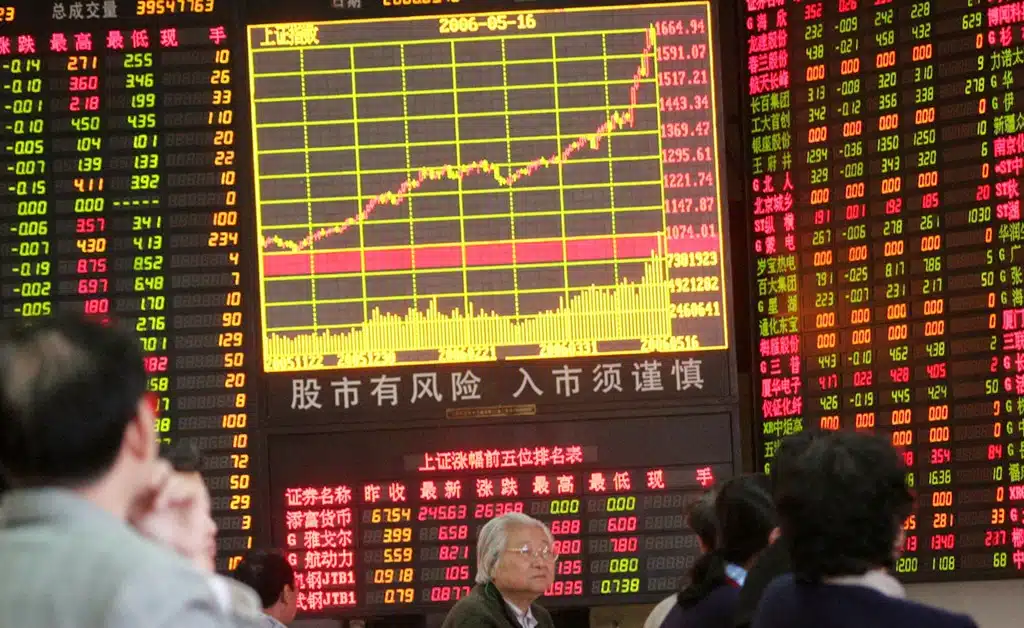
Source: voxchina.org/
China stock market data 2006.
TL;DR
- China is one of the world’s largest economies. The Shanghai and Shenzhen stock exchanges lead the market.
- Recent regulatory reforms have prioritized transparency and accessibility for domestic and foreign investors.
- Consumer goods, tech, health, and government-prioritized sectors are the most prominent.
- Geopolitical influence is a significant influence on the China stock markets.
- Macroeconomic factors shape market performance
- China’s market is complex. Understanding the nuances leads to higher profitability for investors.
Overview of the Chinese Stock Market
The Chinese stock market plays a pivotal role in the growth of the second-largest economy in the world. The growth of China stocks is interesting to watch, especially considering the potential global impact. Consider, for example, the economic impact of Feb 2024 when the China market hit its lowest level since 2019.
To understand the Chinese stock market, it’s important to look closely at the two stock exchanges that serve as its main foundation – the Shanghai Stock Exchange and the Shenzhen Stock Exchange. Combined, these two stock exchanges are the core of China’s domestic capital markets.
Within the Chinese stock exchanges is listed a diverse range of companies. This includes more than 5,000 companies, ranging from new tech startups to massive state-owned enterprises (SOEs).
As we dive into detail about the stock market in China, we invite you to our Tiingo blog to learn more about global financial markets.
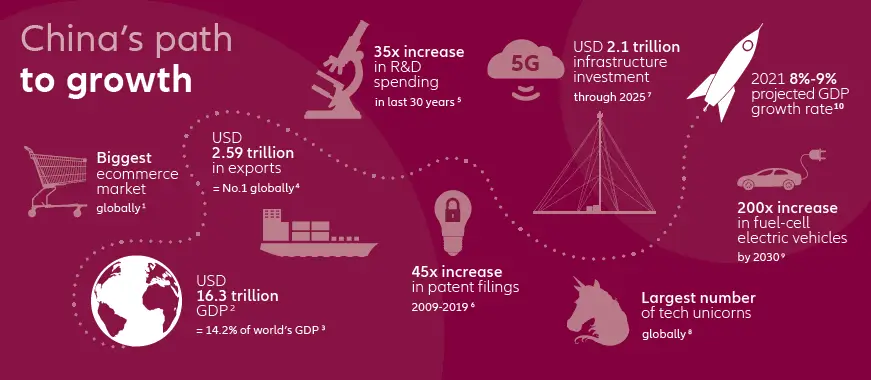
Image Credit: Allianzgi
Chinese Stock Market Growth
Shanghai Stock Exchange (SSE)
The Shanghai Stock Exchange (SSE) is the oldest and most influential stock exchange in China and the third largest in the world in terms of market capitalization. The SSE dates back to 1860 but was closed down in the mid-twentieth century, to be reopened in 1990. As the most influential stock exchange in China, the SSE has played a significant role in China’s economic ambitions, offering a premium market for blue-chip companies. Currently, the Shanghai Stock Exchange is not fully open to foreign investors.
SSE Composite Index
The SSE Composite Index is a Chinese stock market index that tracks stocks listed on the Shanghai Stock Exchange. This includes both A-shares and B-shares.
A-shares make up the largest portion of the market and are available almost exclusively to domestic investors. International investors can trade A-shares within defined regulatory frameworks. A-shares are denominated in Chinese yuan (RMB).
In contrast, B-shares are denominated in foreign currencies, and have broad appeal for foreign investment. B-shares represent a significantly smaller segment of the Shanghai SE composite.
According to Trading Economics, as of March 2024, the China Shanghai Composite Stock Market Index stands at 3,047.79 points.
Trading Mechanisms
The SSE operates under a unique set of trading mechanisms. These serve the purpose of regulating the market and ensuring market stability. One of these regulations is daily price limits. Daily price limits are typically set at +/- 10% and control how much stocks can move in a single day.
Additionally, there’s the T+1 rule, meaning a stock cannot be sold until the next translation day after purchase. This is a safeguard for reducing intraday trading and reducing market speculation.
Shenzhen Stock Exchange
The Shenzhen Stock Exchange is the second major Chinese stock exchange. Compared to SSE, the Shenzhen Stock Exchange is more focused on economic growth through fostering innovation, especially in technology. Many refer to this stock exchange as the place where China’s tech dreams come to life. The Shenzhen Stock Exchange also has a reputation as being the more volatile of the two.

Image Credit: Wikipedia
Shenzhen Stock Exchange
ChiNext Board
The ChiNext Board is one of the specialized trading platforms under the Shenzhen Stock Exchange. It was developed specifically to support innovative startups as well as high-growth companies. The ChiNext Board is a critical player in China’s economic strategy for the future. It’s comparable to NASDAQ in the U.S. and has strong investor appeal among those looking for riskier ventures.
Market Participants
When looking at the Chinese stock market, you see an interesting ecosystem built from diverse market participants. Overall, market participants can be placed into three main categories. These include retail investors, institutional investors, and foreign investors.
In the past, retail investors have been the formidable base of the Chinese stock market. However, the dynamics are shifting. The market is currently seeing a surge in institutional and foreign investors. Each participant brings a different dynamic to the market, including large pools of capital, pricing stability, and growth prospects.
Retail Investors
Considering that retail investors are the driving force of market participants, their influence is significant. They dominate the trading volume and, with that, shape market trends.
Retail investors are known for certain behaviors. Among these are speculative trading, which can generate quick profits, and high-frequency trading. Retail investors are notorious for their rapid response to market news. This is also one of their behaviors that leads to greater market volatility.
An important feature of retail investors is their fascination with social media influence. The instantaneous spread of information through these changes leads to a significant push in investor behaviors. Retail investors are also likely to use mobile trading apps for quick decisions made on the go. Due to their need for speed, many retail investors are keen on algorithmic trading.
Foreign Investors
The influx of foreign investors into the Chinese stock market is a relatively new trend. As part of a broader strategy growth, foreign investment has surged in the past decade. Attracting foreign capital helps support Chinese economic development.
Several key programs have been established to support foreign investment. These include Qualified Foreign Institutional Investor (QFII) and Stock Connect.
QFII, introduced in 2002, was pivotal for allowing foreign investors the ability to invest in Chinese stock markets. QFII has expanded over the years and includes a more expansive range of eligible foreign investors.
Stock Connect is a more recent initiative. It allows foreign investors to trade on the SSE and Shenzhen Stock Exchange through the Hong Kong Stock Exchange. The straightforwardness of this program has increased foreign investor participation across the board.
Regulatory Environment and Market Reforms
The regulatory environment of the Chinese stock market is one controlled by a small handful of players. Together, they safeguard the stability of the Chinese stock market and work to build investor confidence.
More recently, there has been movement toward market reforms and greater transparency in the China Stock Exchange. Let’s take a closer look at the current regulatory landscape.

Image Credit: Wikipedia Commons
Exchange Square in China.
Key Regulatory Bodies
The key regulatory bodies are what keep the Chinese stock market in check. Each regulatory body serves a unique purpose in ensuring the market remains stable while continuing to grow.
These regulatory bodies include the China Securities Regulatory Commission (CSRC) and the People’s Bank of China (PBOC). Additionally, the State Administration of Foreign Exchange (SAFE) also serves as a governing body.
China Securities Regulatory Commission (CSRC)
The CSRC is the regulatory authority that holds the most power in the Chinese stock market. They’re the ones responsible for protecting investors against the consequences of unethical practices. Actions like insider trading and market manipulation are big on the CSRC radar.
The CSRC has been behind some notable initiatives. For instance, they’ve promoted the transition to a registration-based IPO system. This has eased the process of companies going public, without compromising on disclosure requirements.
People’s Bank of China (PBOC)
The People’s Bank of China (PBOC) holds the reins of managing the economic conditions of the Chinese stock market. They enforce monetary policies, set interest rates, and adjust reserve requirements. This essentially equates to the PBOC controlling the liquidity of the Chinese financial system. For instance, by changing reserve requirements, they regulate how much money a bank can lend. This has a direct impact on market liquidity.
Recent Regulatory Developments
We’ve seen some key regulatory developments in the Chinese stock market recently. These include the shift to a registration-based IPO system mentioned above and the introduction of new ESG reporting requirements.
The far-reaching goal of these regulatory changes has been to attract a broader range of companies, especially innovative firms with high growth potential. Additionally, they’ve brought about greater transparency and sustainable business practices.
Registration-based IPO System
With the registration-based IPO system, the focus leans heavily on disclosure requirements. This is meant to encourage greater completeness and accuracy of disclosure requirements. This is a change from seeking regulatory approval for each IPO. Once the disclosure standards have been met, a company can then go public.
This is a highly market-driven approach that offers greater efficiency and benefits high-growth firms with expanded access to capital.
ESG Reporting Requirements
ESG reporting requirements have been hugely impactful on the corporate landscape. With the ESG, companies are required to provide transparent reports on certain business practices. These include environmental, social, and governance policies.
The goal is to encourage companies to act as responsible corporate citizens and provide insights into the company’s ethical standards. One concern of ESG reporting requirements is that they encourage greenwashing. This is when companies exaggerate their ESG efforts. Still, ESG reporting offers investors the opportunity to invest in companies they feel ethically aligned with.
Market Accessibility for Foreign Investors
One element of the Chinese stock market that has changed in recent years is the foreign investment landscape. Several programs have been designed to expand foreign investor participation. One of these programs is Stock Connect. The other two key programs are the Qualified Foreign Institutional Investor (QFII) and Renminbi Qualified Foreign Institutional Investor (RQFII).
Let’s look at how these programs increase market accessibility.
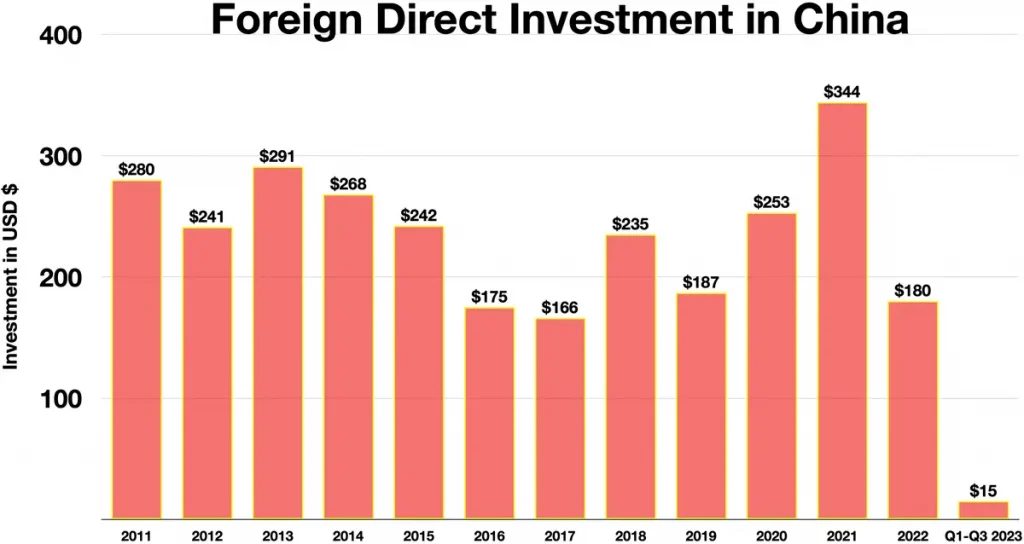
Image Credit: Wikimedia
Foreign Investment in China
Expansion of Stock Connect Programs
The Stock Connect program is crucial for leading the China stock market further into global integration. This program was implemented a decade ago and helps to connect the Chinese stock market directly to the Hong Stock Exchange. For starters, this has allowed foreign investors to purchase A-shares. Additionally, domestic investors have broad access to Hong Kong-listed stocks.
Recent expansions to Stock Connect have focused on raising trading quotas and growing the list of eligible stocks. This has made the market more attractive to both foreign and domestic investors by leveling up investment opportunities.
QFII and RQFII Reforms
The QFII and RQFII programs have been crucial in increasing access for foreign investors. In short, these programs allow foreign investors to participate in China’s stock market, without the constraints of previous restrictions.
Before reforms, the China market was controlled by strict investment quotas. However, recent reforms have expanded the scope of these programs. In addition to modifying investment quotas, we have seen an expanded investment scope.
Although beneficial, there are still some challenges that persist with these programs. For example, the approval process has been simplified, but it’s still complex. The time investment is something that can be seen as an obstacle. While these challenges persist, the benefits of these programs to China’s financial outlook are substantial.
Investment Strategies and Opportunities
Now that we’ve covered the basics of the Chinese stock market, let’s talk about investment strategies. For investors, there are opportunities across multiple sectors. Areas to consider are tech stocks with their growth potential, and consumer goods, which are always a strong focus. Consider also opportunities like infrastructure and renewable energy, which fall under the category of government projects.
Due to the shifting landscape of the market, staying informed about policy changes and economic shifts is essential. At Tiingo, we can help you stay informed. Learn more about Tiingo and our expertise in financial data and analysis by visiting our site
Sector Analysis and Trends
Within the Chinese stock market, there are always shifting performance trends. Looking at consumer goods, we see continual, robust growth that is driven by the purchasing power of the middle class. Then, with the tech sector, it’s exciting to see how cutting-edge technologies are driving market growth. Other sectors highlight government priorities, like green energy, and are known to spark investor enthusiasm.
Understanding China’s economic goals and policy priorities is key for analyzing market potential across each of these sectors.
Technology and Innovation
China is emerging as a major force in the tech sector, being a leader in tech innovation. What is really driving market growth in the tech sector at the moment is AI technology. AI capabilities seem to have endless innovative potential. The semiconductor industry is an area in particular that has been prioritized, as it’s key to China’s digital infrastructure.
There have also been recent regulatory changes that offer both benefits and downsides. In the end, recent regulatory changes have done more to support a more competitive market environment.

Image Credit: Wikimedia Commons
China Science & Technology Expo
Consumer Goods and Services
China’s consumer goods and services sector has seen significant shifts in recent years as consumer behaviors have changed drastically. For example, the rapid expansion of e-commerce has redefined the retail sector. Another area of interest is luxury goods, which have seen growth due to China’s changing demographics.
Even sectors like healthcare have experienced significant growth. An aging population and a growing, health-focused middle class have driven much of this growth.
Risk Management Strategies
There’s a level of volatility and potential for government intervention in Chinese stocks. These factors mean that market investors must consider robust risk management strategies. It’s important to stay informed about regulatory changes, but diversification is still key. Investors can reduce the impact of risk by diversifying across multiple sectors and asset types, such as A-shares and H-shares.
Diversification
Regardless of which market you’re talking about, portfolio diversification is always smart. The Chinese stock market can be prone to sector-specific volatility, and a diversified portfolio helps protect against the risk. In addition to risk mitigation, diversification also offers greater growth potential.
A well-diversified portfolio should provide a balance of stability and growth potential with a moderate risk. For example, tech startups are known for growth but aren’t as stable as state-owned enterprises. Adding Hong Kong-listed shares is a smart strategy for increasing profit potential.
Due Diligence and Corporate Governance
Investing in the Chinese stock market requires investors to perform a high level of due diligence. The Chinese business environment has challenges making it difficult to assess a company’s financial standing and corporate governance policies. Compared to Western markets, China’s regulatory policies aren’t as transparent. This can pose a higher risk for minority stakeholders.
Looking at a company’s financial health with a fine tooth comb is crucial. Look for red flags, such as inconsistent financial statements or an abrupt management turnover. Consider using third-party resources for a company’s financial analysis, and look for independent research on company outlook.
Emerging Investment Themes
Successful investors keep their attention on emerging investment trends, and we’re seeing several come to the forefront. One theme that is on its way to becoming a megatrend is ESG investing. Investors are increasingly committed to companies that align with their environmental and social ideals. Self-reliance in tech is another noteworthy megatrend.
Today, the theme of common prosperity is important to investors, as wealth redistribution and social equity remain hot topics. Themes like these, and others, have a driving impact on stock market performance.

Image Credit: Wikipedia Commons
ESG Investing.
ESG Investing
All eyes are on environmental, social, and governance (ESG) investing. With ESG investing, potential investors consider a company’s non-financial traits before investing. These encompass areas such as carbon neutrality, social responsibility, sustainable development, and governance practices. These are policies that have the potential to transform the investment landscape.
However, inconsistent ESG reporting creates barriers to assessing a company’s true stance and operations. The lack of standardization and transparent data availability are seen as downsides. Still, ESG investing empowers investors to make positive changes through better-informed decisions.
Strategic Emerging Industries
There are several emerging industries that are prioritized by the Chinese government. Among these are industries like quantum computing and biotech. There are also great growth prospects for new energy vehicles and advanced manufacturing.
There’s no question that the growth prospects for these emerging industries are substantial. Add to it that they’re supported by government initiatives, and these industries become drivers of China’s global competitiveness.
Market Dynamics and Trading Characteristics
| Section Title | Overview | Key Terms |
| Market Dynamics and Trading Characteristics | Various factors, including trading hours, price limits, and circuit breakers have a significant impact on the market and trading tactics. | trading hours, price limits, circuit breakers, retail investors |
| Trading Hours and Sessions | Trading hours are from 9:30 am until 3 pm, with a lunch break from 11:30 am until 1 pm. Choosing to trade during the morning session or afternoon sessions is a strategic move. Price gaps between sessions can affect profitability. | morning session, lunch break, afternoon session, price gaps |
| Morning and Afternoon Sessions | Trading patterns tell us morning sessions are typically more volatile. This is due to overnight news and economic data from what happens after the previous day’s closing bell. In contrast, afternoon sessions typically show less volatile trading patterns as the market settles. | overnight news, economic data, closing bell, trading patterns |
| Pre-market and After-hours Trading | The Shanghai Stock Exchange does’t have pre-market trading hours. This results in overnight news that can create price gaps before the market opens. | price gaps, overnight news, market open, price discovery |
| Price Limits and Circuit Breakers | Implementing a daily price limit and circuit breakers helps to stabilize the stock market. Price limits restrict how much a stock can rise or fall during a day. Circuit breakers create trading halts when the market sees extreme movements. | daily price limit, circuit breakers, market liquidity, trading halts |
| Daily Price Limits | Traditionally, the Chinese stock market has implemented a 10% limit to restrict daily movement. This includes both a limit up and limit down. However, in 2020, ChiNext loosed the limit to 20% | 10% limit, limit up, limit down, price discovery |
| Market-wide Circuit Breakers | Market-wide circuit breakers temporarily induce a trading pause when the market index rises or falls by 7% or more. This is to prevent market panic and extreme volatility. | market panic, trading pause, extreme volatility, regulatory framework |
| Margin Trading and Short Selling | Margin trading and short selling provide leverage by allowing investors to borrow in order to enhance their trading positions. Short selling involves borrowing stocks, while margin trading involves borrowing money. | margin trading, short selling, leverage, market volatility |
| Margin Trading Restrictions | China has recently raised the minimum margin requirement ratio. For short selling, the ratio is now 100%, up from 80% | leverage limits, eligible stocks, market liquidity, speculative trading |
| Short Selling Limitations | Limitations on short selling in China have included the T+1 rule. However, China is currently in the process of tightening limitations to improve market efficiency. | T+1 rule, naked short selling, market efficiency, price discovery |
Macroeconomic Factors and Policy Influences
As with every stock market, China’s market operates under the influence of multiple macroeconomic factors. These influences combined shape the broader economic landscape of the Chinese Market. There’s a complex relationship between each of these economic indicators and market performance.
For instance, GDP growth is a strong indicator of market expansion. There are interplays between monetary policy and fiscal policy that play a role. And, let’s not discount geopolitical events that also have an impact on China’s stock market.
Understanding how these influences factor into China’s market performance is important for investors.
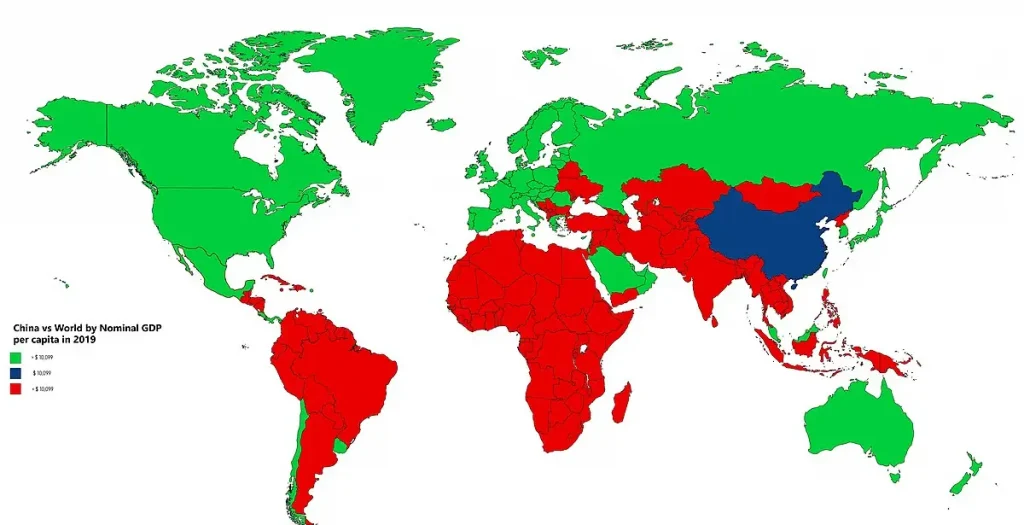
Image Credit: Wikipedia Commons
China Vs World GDP
Economic Growth and Market Performance
The interactions between China’s GDP growth indicators and stock market performance are nuanced, to say the least. It is intuitive to believe that strong GDP growth is going to boost market performance. However, each sector responds in a unique way to economic indicators, which can lead to counterintuitive market reactions.
For instance, a booming housing market could have counterintuitive effects on real estate or construction shares. Likewise, manufacturing data can cause upward and downward trends in industrial stocks. Taking a closer look at these trends can help investors capitalize on somewhat unpredictable market performance.
GDP Growth and Stock Valuations
GDP growth always affects stock valuations, but not always in predictable ways. Different types of economic growth affect market sentiment in varied ways. There are both consumer-led and investment-led growth factors influencing market sentiment.
Taking a look at consumer-led growth, we see this is a response to higher household incomes and spending power. Market sectors like retail, consumer goods, and healthcare generally see higher stock valuations in response to consumer-led growth.
With investment-led growth, the effect on economic indicators is more nuanced. This can include infrastructure projects, construction, materials, and other industrial sectors. However, while expansion signals growth, there are also investor perceptions that can influence the market negatively.
Sectoral Shifts and Market Composition
China’s economic structure and sectoral shifts are reflected directly in its market composition. China is experiencing a shift from industrial and traditional manufacturing sectors to those fueled by innovation. Emerging industries like innovative tech, healthcare, and sustainability through green energy are shifting China’s economic structure.
Each of these sectoral shifts comes with both opportunities and unique challenges for investors. To maintain profitability, investors need to monitor emerging industries and how they’re expected to drive future growth. China stock investors should constantly stay informed about the changes in market indices and how they play into broader market trends.
Monetary and Fiscal Policy Impacts
A strong influence on China’s stock market is monetary and fiscal policies. These are implemented by the People’s Bank of China and are key in shaping market conditions. The bank is central to setting interest rates and reserve requirements, which directly impact market conditions.
For example, when the bank lowers interest rates, this typically translates to a boost in certain sectors like real estate. Construction is another sector that benefits from lower interest rates. In contrast, when interest rates hike, it’s common to see a noticeable tightening across these sectors.
Reserve requirements are another factor that can affect the market through consumer spending. Changes in reserve requirements can create constraints in lending and increase lending costs. These factors can have a significant influence on both corporate expansion and consumer spending, affecting the market in multiple ways.
A response to reduced consumer spending and corporate expansion are fiscal stimulus measures. The Chinese government can implement a fiscal stimulus to spark growth, either in individual sectors or across the market for a while. By monitoring government policies, investors can anticipate market sector reactions, and invest accordingly.
Geopolitical Factors and International Relations
There isn’t a leading global economy that acts alone. This is true for China, as it is the world’s second-largest economy. The United States, which is the world’s first leading economy, has a strong influence on China’s stock market. US-China relations aren’t a stranger to tensions in trade negotiations. Ongoing trade negotiations and tariff disputes between the two economies affect supply chains and keep savvy investors on their toes. Technology, agriculture, and manufacturing sectors are heavily impacted by these negotiations.,
Other global initiatives, like the Belt and Road initiative, are also key. The Belt and Road initiative connects China with regions of Asia, Europe, and Russia by land. By expanding routes for commerce, the BRI can have a significant impact on China’s stock market.
However, global initiatives don’t come without risks. Global supply chains, trade disputes, and sectors that are reliant on exports may be negatively impacted. Mitigating political risks in the stock market involves diversifying portfolios and monitoring geopolitical developments.
Trade Relations and Tariffs
Trade relations and tariffs are major players in the Chinese stock market. Take, for example, the long history of the US-China Trade War and how it has affected export-oriented stocks. The semiconductor supply chain battles have affected demand, thus affecting market performance. Additionally, sectors like agriculture, manufacturing, and technology have been hit hard with tariff increases.
A good strategy for minimizing trade-related risks is for investors to diversify their portfolios across different supply chains. Highlight investment opportunities that focus on domestic demand, rather than going all in on sectors with dependency on exports.
Ongoing trade tensions between China and the US are sure to create long-term shifts in China’s market dynamics. Strategic positioning and keeping up with the global trade environment are essentials for investors.
Learnings Recap
The China stock market is a force behind one of the world’s leading economies. There’s a lot to learn and understand for investors to leverage its profitability. Here are a few key takeaways we’ve covered:
- China is the second-largest global economy.
- The Chinese stock market is relatively young compared to other top global markets.
- The two main stock exchanges are the Shanghai Stock Exchange and the Shenzhen Stock Exchange.
- China’s stock market is nuanced, with the influence of communism and capitalism.
- Frequent regulatory changes mean continual shifts in market performance.
- Recently, sectors like technology and innovation have drastically shifted the market.
- It’s critical for investors to consider macroeconomic factors when investing in the market.
- Geopolitical happenings are largely influential in supply chain, demand, and market performance.
- Diversification is an effective strategy for maximizing profitability in the Chinese stock market.
- Investors should stay up to date on market news, geopolitical happenings, and regulatory changes in China.
Final Thoughts
If you’re considering investment in the Chinese stock market but feel a little overwhelmed by all there is to learn and consider, you’re not alone. The China stock market offers the potential for maximum profitability, but you need to know how to leverage it. Tools like Tiingo’s Stock API can help.
Tiingo can be your trusted partner in investing. We provide fundamental data API, to help you make sense of markets, and navigate them with confidence.
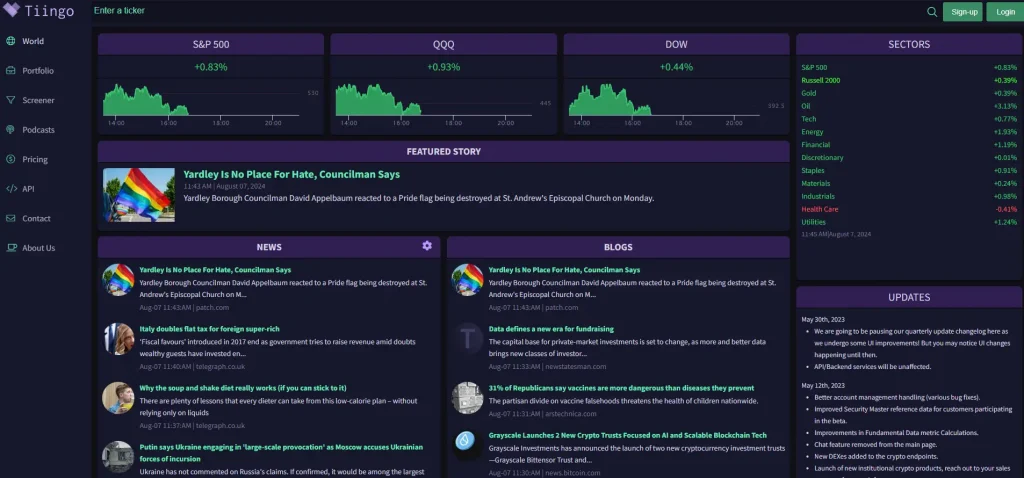
Image Credit: Tiingo
Whether you’re an experienced investor or new to stock markets, the Tiingo App is your new best friend. The Chinese stock market is an incredible investment opportunity, and armed with the right tools, can expand your investment portfolio. Check out Tiingo and learn more about our API today.
Leave a Reply